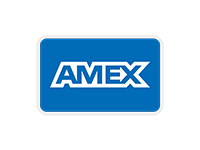By Josh Anderchek and Dan Garcia
Conception
Double-deck and bilevel commuter cars have been used for many years in Europe. The concept hadn’t caught on nearly as quickly in North America, where train lengths were not nearly as limited and the larger loading gauge of the North American railroads allowed for the use of larger cars – with their corresponding larger capacity. As well, several railroads, particularly in the Chicago area, preferred “Gallery”-style cars with an open second level.
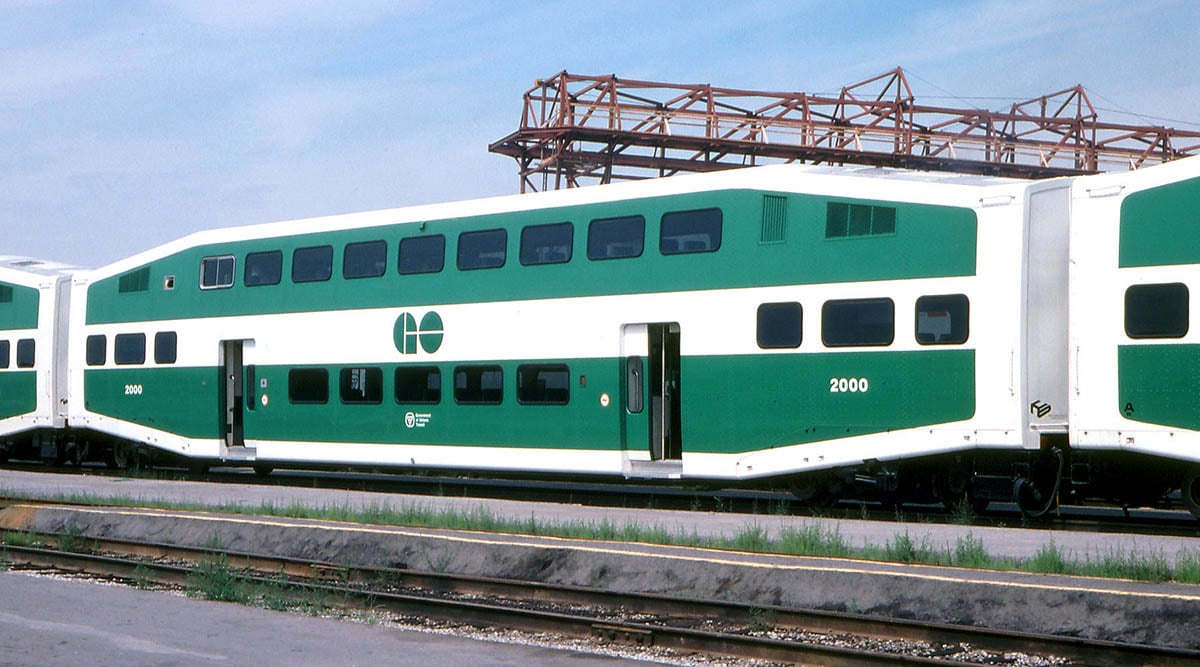
The original BiLevel car, GO Transit 2000, seen here in 1978. Dan Dell'Unto collection.
The BiLevel Commuter Car was originally designed in the mid-1970s at the request of the Government of Ontario (Canada) to develop a higher-capacity solution for their GO Transit commuter trains in the Greater Toronto Area. Their train lengths had grown to 10-car single-level trains during peak times and it was felt that the ideal solution was to increase the height rather than length of the trains.
Originally designed by Hawker Siddeley Canada, with help from Dofasco and the Urban Transportation Development Corporation (UTDC), the cars have been manufactured over the years by Hawker Siddeley, UTDC, SNC-Lavalin, and today, Bombardier. Since their creation, the cars have been built at the original Canadian Car & Foundry (CanCar) factory in Thunder Bay, Ontario, although some finishing of the cars has occurred at other Bombardier facilities where required.

Cross-section showing general arrangement of the BiLevel Car design.
In 1989, the first BiLevel cars were introduced to the United States by Tri-Rail in the Miami area. In 1992, Metrolink in the Los Angeles area started operation and introduced the design to the West Coast. This spurred further orders elsewhere in California including Coaster of San Diego and Altamont Commuter Express (now Altamont Corridor Express) of San Jose. By the 2000s, more agencies across North America began using the BiLevel Commuter Cars for start-up commuter operations, such as Sounder in Seattle, RailRunner in Albuquerque and Northstar in Minnesota, just to name a few. As of early 2021, 14 agencies across North America operate fleets totaling almost 1500 BiLevel Commuter Cars.
Design
The structural design of the car is vastly different than most passenger cars previously built in North America. Rather than using large steel I-beams and structural shapes to create a flat, strong floor on which the car is built, the car is built of two primary components – the steel floor, which provides much of the strength and to which the trucks, draft gear and other mechanical components are mounted, and the aluminum body which gives the rest of the car its strength as well as providing the enclosure for the passengers. This results in a car, while physically large and imposing, that weighs around the same as the average "lightweight" passenger car built after the Second World War.
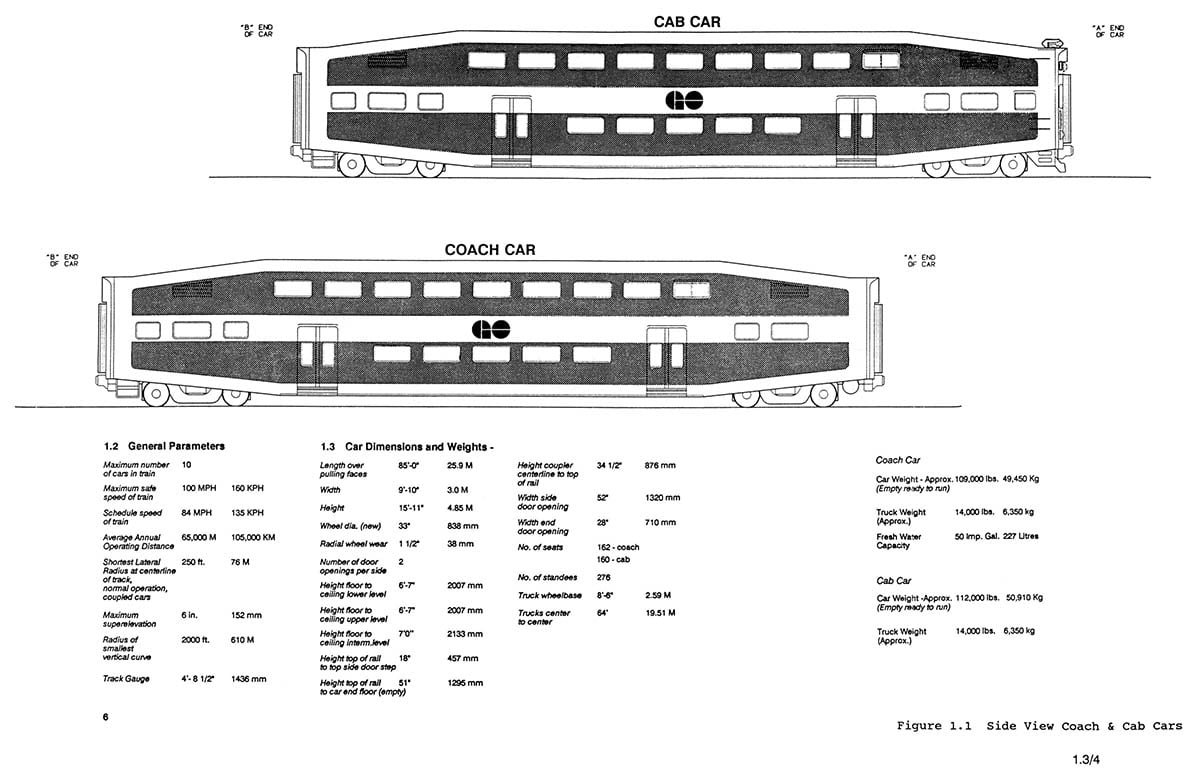
Exterior dimensions and general arrangement of the BiLevel Car design.
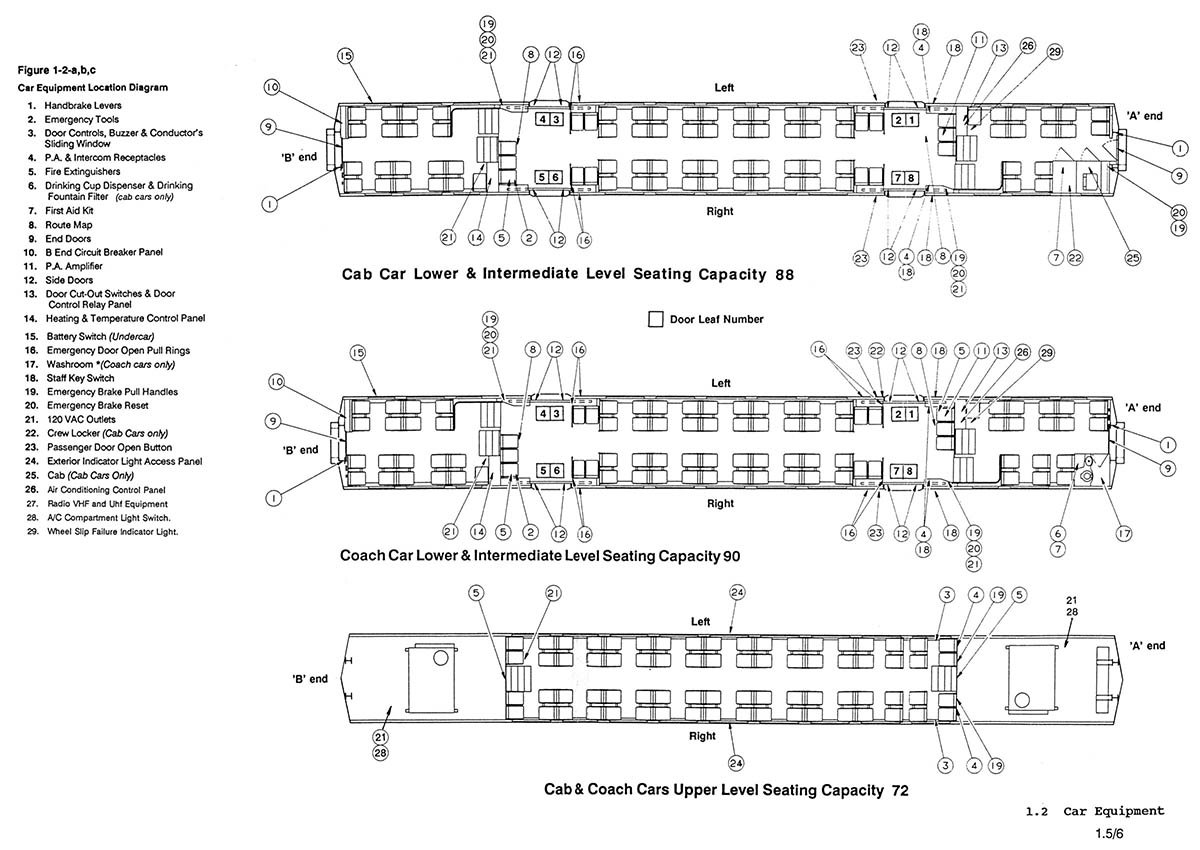
Interior appliance and switch of the BiLevel Car design.
Early on, the bodies of the car were riveted together. At that time welding large, flat aluminum sheets was not seen as an exact science, and riveting panels and structural sections allowed for a reduction in the number of different panels that needed to be stamped. As the technology advanced, the change was made to weld the body panels and components together as it allowed for a more streamlined and easier-to-maintain structure.
The cars are configured as a set of 4 tubes - the lower level and upper levels stacked one above the other, and the intermediate levels over the trucks. All passenger-carrying spaces are designed to be as open as possible for maximum flexibility, with the various electrical and mechanical bits located under the floor, around the stairwells joining the levels, routed alongside the lighting or above the intermediate levels. While the floor of the lower level is just 15 inches above the rail, the floor of the intermediate levels are located at the standard 51 inches above the rail, allowing the cars to be used with other standard rolling stock. The carbody design even allows for doorways to line up with North America's 48 inch high-level platform standard - although no cars have been built with doors at that height.
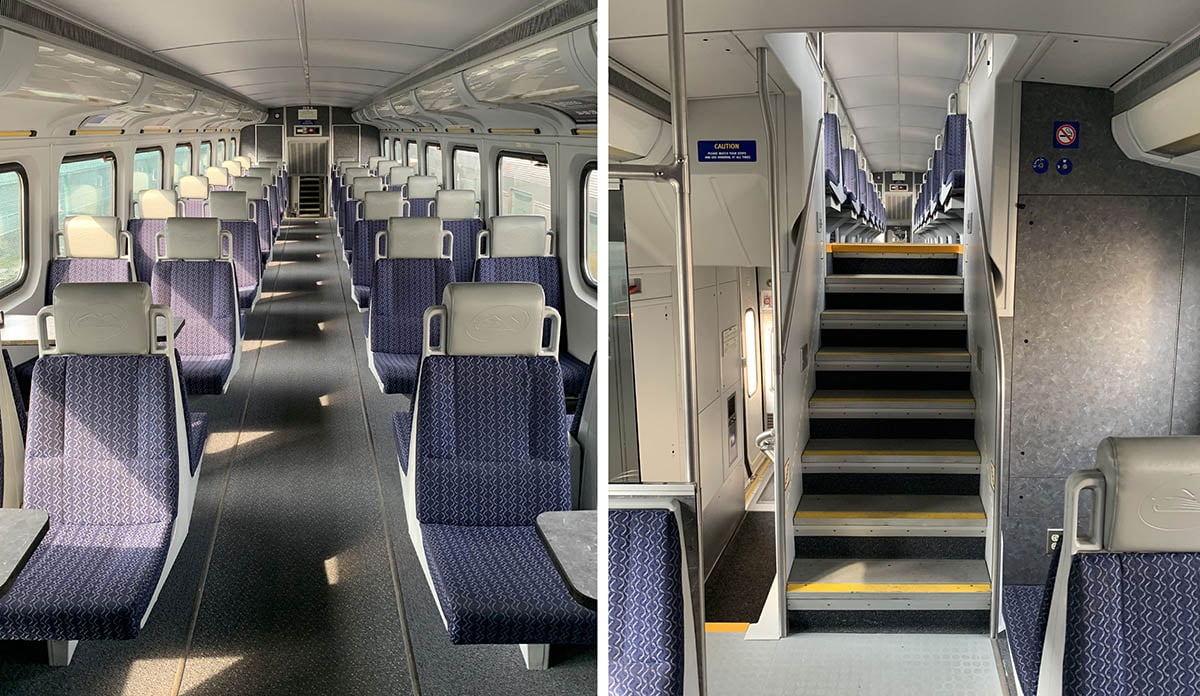
(Left) Upper level showing paired seating, some with tables. (Right) Transition from Intermediate level to the lower and upper levels. Translink (West Coast Express) photos.
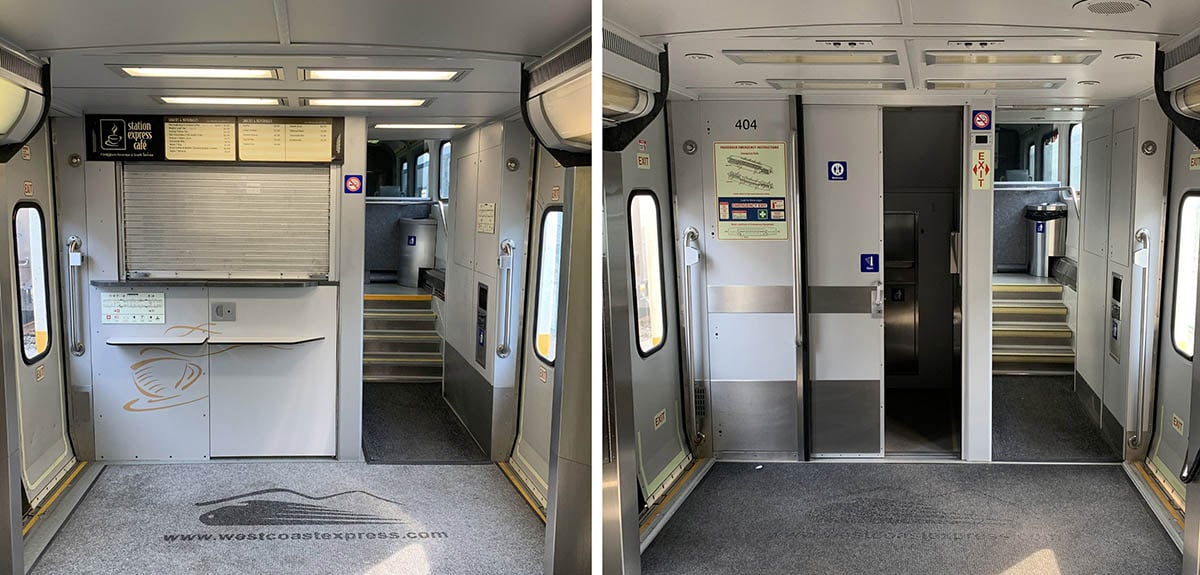
Starting with the Series II cars, the washrooms were relocated to the lower level for improved accessibility (right). For a special fleet of cars operated by West Coast Express, they've used this area instead for an on-board coffee shop (left). Translink (West Coast Express) photos.
The Bilevel Commuter Car, having been in production since 1976, has gone through a number of changes and improvements over the years, but the general design and appearance has remained largely unchanged. It has colloquially become known as the “Lozenge” design, with GO Transit even using the outline of the design on some signage. The BiLevel Commuter Car design can be broken down into 5 distinct versions or “series”.
Please note that these series are based on general changes to the design over the years and are not the same as the “series” designations as used by GO Transit or Metrolink.
Series I
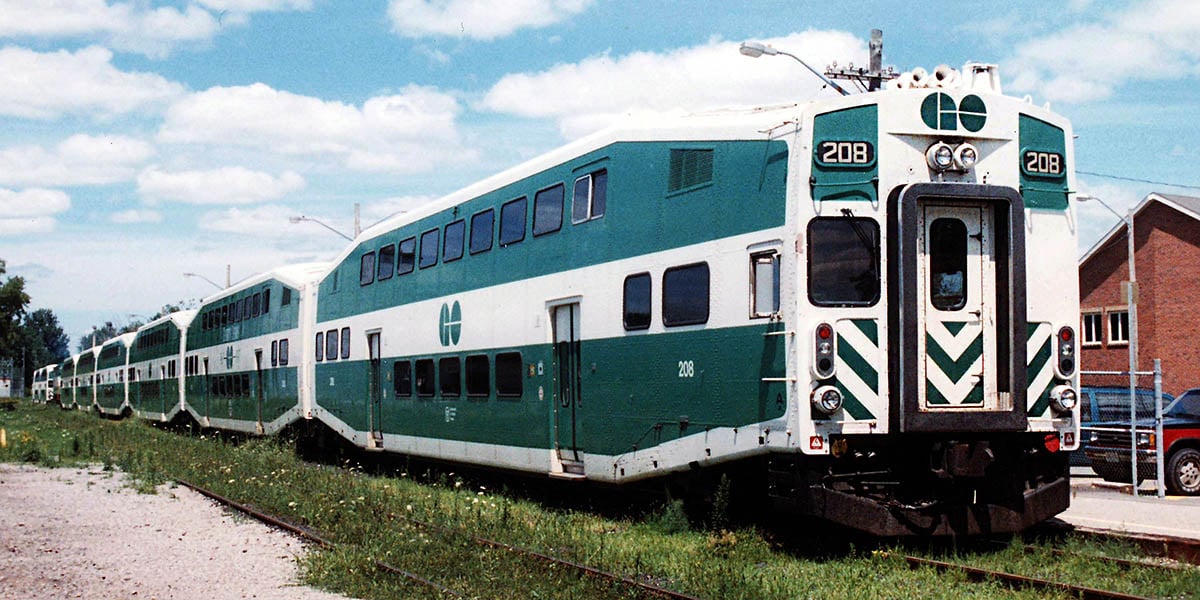
A pair of GO Transit trains, consisting entirely of Series I cars, rest for the weekend at Stouffville, just northeast of Toronto, Ontario. Dan Darnell photo.
The first cars built featured a “symmetrical” design end-to-end, with 5 large windows on the lower level between a pair of large, 52" wide doorways, riveted aluminum side panels and washrooms at the A-end of the intermediate level - where the cab would be later located on a cab car. The first 80 cars built had additional vents on either side for their heating and air conditioning systems which were later plated over - and which have not appeared on any models since. The first cab cars were built with a single engineer’s window cut into the end of the car and a small cab with room for just the single operator. Cars of this design were built until 1992.
Series II
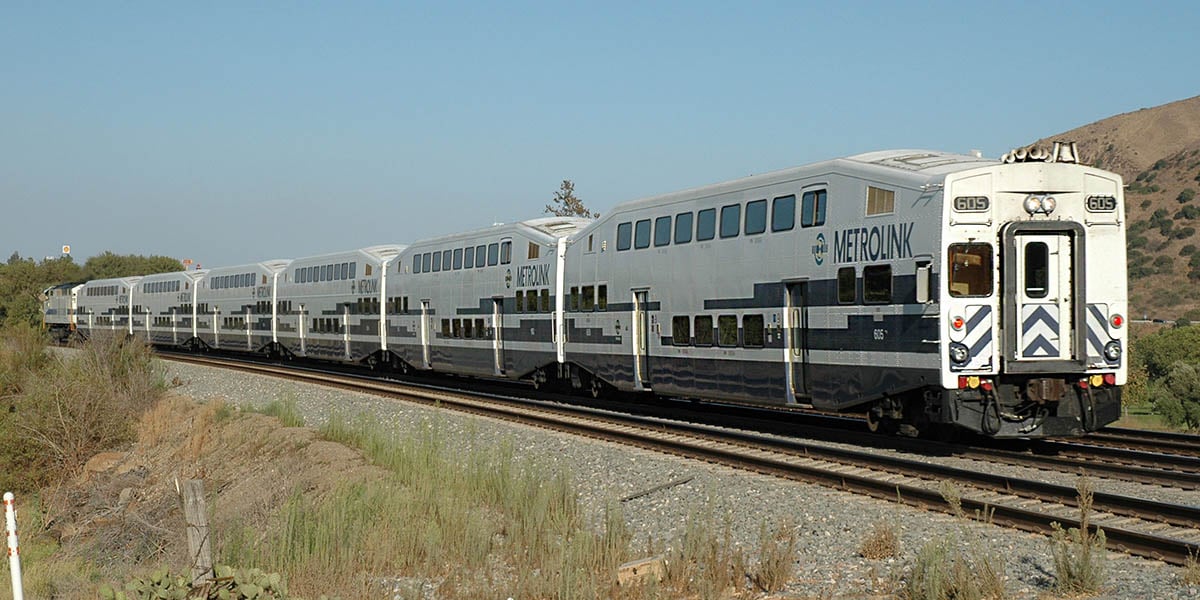
This 6-car Metrolink train consits of a 50/50 mix of both Series II and Series III cars. The cab car, first coach and second-last coach are Series II cars, as denoted by the body rivets. Craig Walker photo.
The second design of cars shares the same riveted construction as the first, but featured changes to the lower level to improve accessibility. These cars were first introduced by Metrolink in 1992 and feature only 4 windows on the lower level, a relocated doorway on each side at the “B” end of the car, and a new accessible washroom on the lower level located in the additional space between the relocated door and the interior stairwells. As a result, the intermediate-level washroom was eliminated. When this series was first built, cab cars continued to only feature a single engineers window and a small cab, although this was changed in the mid-90s to include a larger, full-width cab compartment and a second, conductor’s window as standard.
Series IISeries III
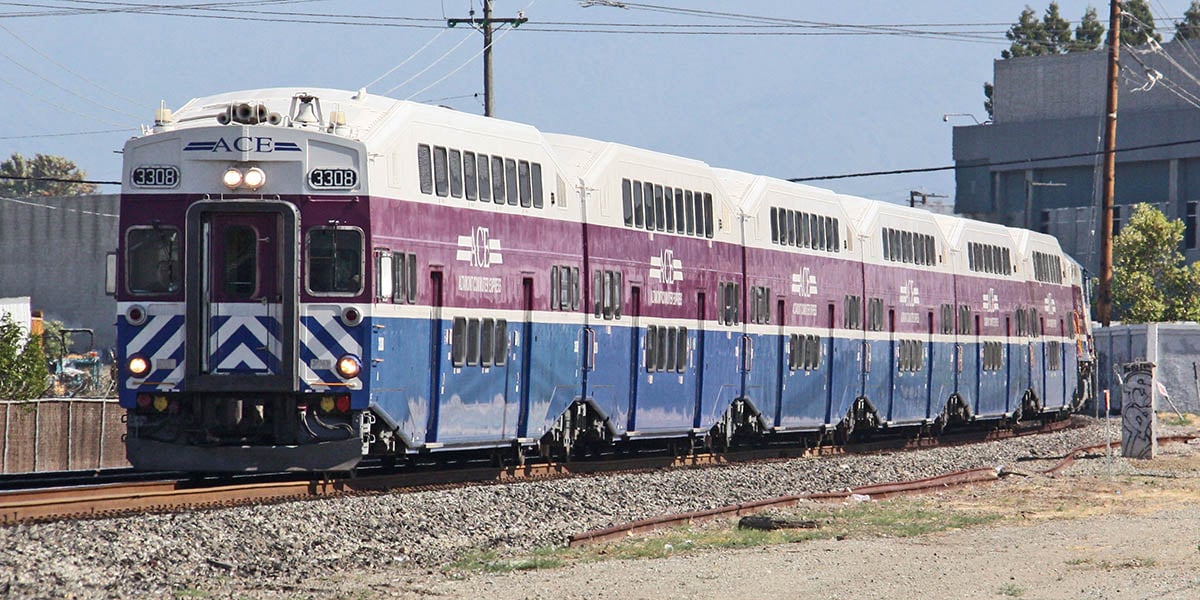
This consist for Altamont Commuter Express (now Altamont Corridor Express) consists of mostly Series III cars. Only the second and last cars are Series IV (note the larger windows). Dale Martin photo.
A significant exterior change occurred with the introduction of the Series III car design. While these cars were nearly identical in design and features to the Series II cars, the trademark riveted exterior side panels were gone - replaced by smooth, welded body panels that also featured a transverse rib running the length of the car above the intermediate windows. The construction and configuration of the cars remained largely identical otherwise.
One car was built early on as part of a GO Transit order in 1992 (car 2499), and while it sports some minor differences to the standard production cars it is considered one of them all the same. By and large production started on this design in 1997.
Series IV
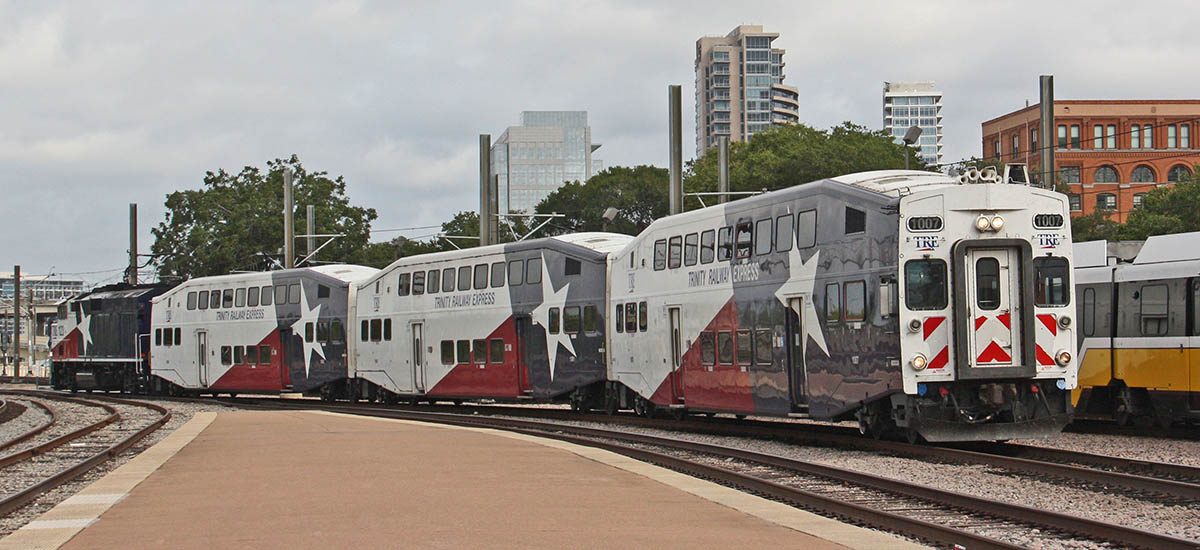
A short 3-car Trinity Rail Express train, consisting of all Series IV cars, pulls into Dallas Union Station. Dale Martin photo.
There are subtle changes to the Series IV car design – most of them are mechanical – but the most significant improvement noteable to passengers over the Series III car was the enlargement of all the side windows. This is particularly noticeable on paint schemes with longitudinal design elements. Another subtle change was to the end cap of the non-cab end of the cars, which now shares more design elements to the cab car face (just without the windows) such as a horizontal rib near the top. These cars started to be built in 2003.
Series X
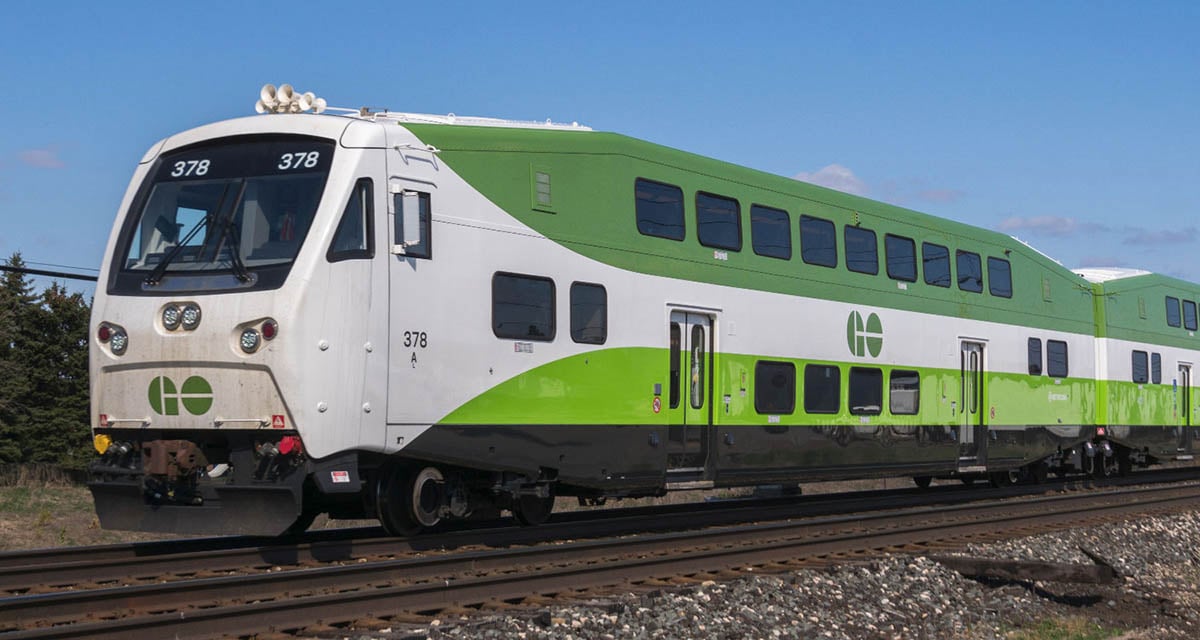
A Series X Cab Car and Coach lead a GO Train west of Toronto. Note the significant change in style versus the earlier Cab Car designs. David Vincent photo.
Introduced in 2014, the Series X cars are the newest type of BiLevel and are completely different to the previous designs, both in appearance and structurally. The acronym “CEM” stands for Crash Energy Management, and refers to a number of additional safety features that have been designed and built into the cars. Following a number of deadly accidents involving commuter trains across North America, Bombardier redesigned the BiLevel to be safer. The end result was an enhanced structure made with more steel, pushback couplers and new crumple zones on each end of the intermediate level (which resulted in the loss of the small windows at both ends) to help absorb the forces in an accident. This has also resulted in minor changes to the original “Lozenge” profile of the cars. Bombardier also designed a completely new cab for the new car design, which features a more streamlined appearance as well as improved sightlines, ergonomics and a safer operating position for crews.
Rosters
| Railroad | Roadnumbers | Quantity | Type | Builder | Series | Built | Notes |
|---|---|---|---|---|---|---|---|
| Agence Metropolitaine de Transport(1) | 2000-2003 | 4 | Cab Car | Bombardier | IV | 2004-05 | |
| Agence Metropolitaine de Transport(1) | 2020-2037 | 18 | Coach | Bombardier | IV | 2004-05 | |
| Altamont Commuter Express | 3301-3304 | 4 | Cab Car | Bombardier | II | 1998 | |
| Altamont Commuter Express | 3201-3204 | 4 | Coach | Bombardier | II | 1998 | |
| Altamont Commuter Express | 3305-3309 | 5 | Cab Car | Bombardier | III | 2003 | 3309 damaged in derailment. Renumbered to 3222 in 2016. |
| Altamont Commuter Express | 3205-3212 | 8 | Coach | Bombardier | III | 2003 | |
| Altamont Commuter Express | 3213-3219 | 7 | Coach | Bombardier | IV | 2009 | |
| Altamont Commuter Express | 3220-3221 | 2 | Coach | Bombardier | IV | 2014 | First cars delivered in interim paint scheme. |
| Altamont Commuter Express | 3310-3314 | 5 | Cab Car | Bombardier | X | 2021-22 | First cars delivered in new paint scheme. |
| Altamont Commuter Express | 3223-3234 | 12 | Coach | Bombardier | X | 2021-22 | First cars delivered in new paint scheme. |
| Caltrain | 112-118 | 7 | Cab Car | Bombardier | III | 2000 | Cars were purchased from Sounder in 2002. |
| Caltrain | 219-230 | 12 | Coach | Bombardier | III | 2000 | Cars were purchased from Sounder in 2002. |
| Caltrain | 119-120 | 2 | Cab Car | Bombardier | IV | 2008 | |
| Caltrain | 231-236 | 6 | Coach | Bombardier | IV | 2008 | |
| Coaster | 2301-2308 | 8 | Cab Car | Bombardier | II | 1994 | |
| Coaster | 2201-2208 | 8 | Coach | Bombardier | II | 1994 | |
| Coaster | 2401-2406 | 6 | Coach | Bombardier | III | 1997 | |
| Coaster | 2309-2310 | 2 | Cab Car | Bombardier | IV | 2003 | |
| Coaster | 2501-2504 | 4 | Coach | Bombardier | IV | 2003 | |
| GO Transit | 2000-2079 | 80 | Coach | Hawker Siddeley | I | 1976-78 | 10 cars sold to TRE in 1996. |
| GO Transit | 200-214 | 15 | Cab Car | Hawker Siddeley | I | 1983-84 | First Cab Cars built. |
| GO Transit | 2100-2155 | 56 | Coach | Can-Car Rail | I | 1983-84 | |
| GO Transit | 215-223 | 9 | Cab Car | Can-Car Rail | I | 1987-88 | 223 sold to TRE in 1999. |
| GO Transit | 2200-2153 | 54 | Coach | Lavalin Industries | I | 1987-88 | |
| GO Transit | 224-241 | 18 | Cab Car | Lavalin Industries | I | 1989-90 | 224 sold to TRE in 1999. |
| GO Transit | 2300-2341 | 42 | Coach | Lavalin Industries | I | 1989-90 | |
| GO Transit | 2400-2356, 2499 | 58 | Coach | Lavalin Industries | I | 1990-91 | 2499 built as Series III prototype. |
| GO Transit | 2500-2522 | 22 | Coach | Bombardier | III | 2002 | Cars are configured to be wheelchair accessible. |
| GO Transit | 2522-2541 | 20 | Coach | Bombardier | IV | 2003 | Cars are configured to be wheelchair accessible. |
| GO Transit | 242-245 | 4 | Cab Car | Bombardier | IV | 2004 | |
| GO Transit | 2600-2609 | 10 | Coach | Bombardier | IV | 2004 | |
| GO Transit | 2610-2629 | 20 | Coach | Bombardier | IV | 2005-06 | |
| GO Transit | 246-250 | 5 | Cab Car | Bombardier | IV | 2006 | |
| GO Transit | 2542-2544, 2630-2641 | 15 | Coach | Bombardier | IV | 2006 | 25xx cars are configured to be wheelchair accessible. |
| GO Transit | 2642-2661 | 20 | Coach | Bombardier | IV | 2007 | |
| GO Transit | 251-253 | 3 | Cab Car | Bombardier | IV | 2008 | |
| GO Transit | 2545-2546, 2700-2729 | 32 | Coach | Bombardier | IV | 2008 | 25xx cars are configured to be wheelchair accessible. |
| GO Transit | 2730-2754 | 25 | Coach | Bombardier | IV | 2009-10 | |
| GO Transit | 254 | 1 | Cab Car | Bombardier | IV | 2011 | |
| GO Transit | 2547-2549, 2755-2770 | 19 | Coach | Bombardier | IV | 2011 | 25xx cars are configured to be wheelchair accessible. |
| GO Transit | 255-257 | 3 | Cab Car | Bombardier | IV | 2012 | |
| GO Transit | 2550-2552, 2771-2814 | 45 | Coach | Bombardier | IV | 2012 | 25xx cars are configured to be wheelchair accessible. |
| GO Transit | 2553-2554, 2815-2840 | 16 | Coach | Bombardier | IV | 2013 | 25xx cars are configured to be wheelchair accessible. |
| GO Transit | 2555-2560, 2815-2840 | 23 | Coach | Bombardier | IV | 2014 | 25xx cars are configured to be wheelchair accessible. First cars delivered in new scheme. |
| GO Transit | 300-361 | 62 | Cab Car | Bombardier | X | 2015 | First CEM cars built. |
| GO Transit | 362-366 | 5 | Cab Car | Bombardier | X | 2016-17 | |
| GO Transit | 4500-4504, 4000-4054 | 60 | Coach | Bombardier | X | 2016-17 | 45xx cars are configured to be wheelchair accessible. |
| GO Transit | 367-380 | 14 | Cab Car | Bombardier | X | 2018-19 | |
| GO Transit | 4505-4519, 4055-4149 | 110 | Coach | Bombardier | X | 2018-19 | 45xx cars are configured to be wheelchair accessible. |
| GO Transit | 4520-4528, 4150-4194 | 54 | Coach | Bombardier | X | 2019 | 45xx cars are configured to be wheelchair accessible. |
| GO Transit | 381-385 | 5 | Cab Car | Bombardier | X | 2020 | |
| GO Transit | 4529-4533, 4195-4215 | 26 | Coach | Bombardier | X | 2020 | 45xx cars are configured to be wheelchair accessible. |
| Metrolink | 601-631 | 31 | Cab Car | Lavalin Industries | II | 1992 | |
| Metrolink | 101-163 | 63 | Coach | Lavalin Industries | II | 1992 | |
| Metrolink | 632-637 | 6 | Cab Car | Bombardier | II | 1997 | First cab cars built with full-width cabs. |
| Metrolink | 164-182 | 18 | Coach | Bombardier | II | 1997 | Most cars sold to Caltrain. |
| Metrolink | 183-210 | 27 | Coach | Bombardier | III | 2002 | |
| New Mexico Railrunner | 1101-1109 | 9 | Cab Car | Bombardier | IV | 2005 | |
| New Mexico Railrunner | 1001-1006 | 6 | Coach | Bombardier | IV | 2005 | |
| New Mexico Railrunner | 1007-1013 | 7 | Coach | Bombardier | IV | 2008 | |
| Minnesota Northstar | 601-606 | 6 | Cab Car | Bombardier | IV | 2009 | |
| Minnesota Northstar | 701-712 | 12 | Coach | Bombardier | IV | 2009 | |
| Seattle Sounder | 101-118 | 18 | Cab Car | Bombardier | III | 2000 | Some cars sold to Caltrain in 2002. |
| Seattle Sounder | 201-240 | 40 | Coach | Bombardier | III | 2000 | Some cars sold to Caltrain in 2002. |
| Seattle Sounder | 301-307 | 7 | Cab Car | Bombardier | IV | 2007 | |
| Seattle Sounder | 401-410 | 10 | Coach | Bombardier | IV | 2007 | |
| Seattle Sounder | 320-328 | 9 | Cab Car | Bombardier | X | 2016-17 | |
| Seattle Sounder | 329-331 | 3 | Cab Car | Bombardier | X |
2022 |
|
| SunRail | 2000-2008 | 9 | Cab Car | Bombardier | IV | 2012-13 | |
| SunRail | 3000-3004 | 5 | Coach | Bombardier | IV | 2012-13 | |
| Tri-Rail | 501-506 | 6 | Cab Car | Lavalin Industries | I | 1987 | |
| Tri-Rail | 1001-1012 | 12 | Coach | Lavalin Industries | I | 1987 | |
| Tri-Rail | 1013-1015 | 3 | Coach | Lavalin Industries | IV | 1991 | |
| Tri-Rail | 507-511 | 5 | Cab Car | Bombardier | II | 1996 | |
| Trinity Railway Express | 1050-1059 | 10 | Coach | Hawker Siddeley | I | 1976-78 | Ex-GO Transit, purchased in 1996. |
| Trinity Railway Express | 1000 | 1 | Cab Car | Can-Car Rail | I | 1987-89 | Ex-GO Transit, purchased in 1999. |
| Trinity Railway Express | 1001 | 1 | Cab Car | Lavalin Industries | I | 1989-90 | Ex-GO Transit, purchased in 1999. |
| Trinity Railway Express | 1002-1003 | 2 | Cab Car | Bombardier | III | 2000 | |
| Trinity Railway Express | 1004-1006 | 3 | Cab Car | Bombardier | IV | 2003 | |
| Trinity Railway Express | 1007-1008 | 2 | Cab Car | Bombardier | IV | 2007 | |
| Trinity Railway Express | 1060-1061 | 2 | Coach | Bombardier | IV | 2007 | |
| UTA FrontRunner | 101-112 | 12 | Cab Car | Bombardier | IV | 2007 | |
| UTA FrontRunner | 201-208 | 8 | Coach | Bombardier | IV | 2007 | |
| UTA FrontRunner | 113-124 | 12 | Cab Car | Bombardier | IV | 2009-10 | |
| UTA FrontRunner | 209-216 | 8 | Coach | Bombardier | IV | 2009-10 | |
| West Coast Express | 101-108 | 8 | Cab Car | Bombardier | II | 1995 | |
| West Coast Express | 201-220 | 20 | Coach | Bombardier | II | 1995 | 201-205 are equipped with a coffee shop in place of the washroom. |
| West Coast Express | 301-309 | 9 | Coach | Bombardier | III | 2000-01 | |
| West Coast Express | 109 | 1 | Cab Car | Bombardier | IV | 2010 | First cars delivered in new paint scheme. |
| West Coast Express | 401-406 | 6 | Coach | Bombardier | IV | 2010 | First cars delivered in new paint scheme. |
| Total Cars Built at end of 2020 | 1477 | ||||||
Acknowledgements
Many thanks are necessary to Dan Dell'unto, Chris Fox, Dakota Lee, Dale Martin and David Vincent for their help with the researching and compiling of this Master Class.


